Effect of Pulse Current Density on Microstructure of Ti-6Al-4V Alloy by Laser Powder Bed Fusion
Abstract
:1. Introduction
2. Experimental Details
3. Results
3.1. Phase Constituents and Lattice Constants
3.2. Microstructure Characteristics
3.2.1. The Characteristics of Prior β Grains
3.2.2. The Characteristics of α′ Martensite
3.2.3. Orientation Relationship (OR) between α′ and β
3.3. Mechanical Properties
4. Discussion
4.1. The Recrystallization of the α′ Martensites
4.2. The Fragmentation of the α′ Martensites
4.3. The Grading Microstructure Related with the Mechanical Property
5. Conclusions
Author Contributions
Funding
Data Availability Statement
Acknowledgments
Conflicts of Interest
References
- Wu, S.Q.; Lu, Y.J.; Gan, Y.L.; Huang, T.T.; Zhao, C.Q.; Lin, J.J.; Guo, S.J.; Lin, X. Microstructural evolution and microhardness of a selective-laser-melted Ti–6Al–4V alloy after post heat treatments. J. Alloys Compd. 2016, 672, 643–652. [Google Scholar] [CrossRef]
- Alfaify, A.Y.; Hughes, J.; Ridgway, K. Critical evaluation of the pulsed selective laser melting process when fabricating Ti64 parts using a range of particle size distributions. Addit. Manuf. 2017, 19, 197–204. [Google Scholar] [CrossRef]
- Qiu, C.; Adkins, N.J.E.; Attallah, M.M. Microstructure and tensile properties of selectively laser-melted and of HIPed laser-melted Ti–6Al–4V. Mater. Sci. Eng. A. 2013, 578, 230–239. [Google Scholar] [CrossRef]
- Shen, X.J.; Zhang, C.; Yang, Y.G.; Liu, L. On the microstructure, mechanical properties and wear resistance of an additively manufactured Ti64/metallic glass composite. Addit. Manuf. 2019, 25, 499–510. [Google Scholar] [CrossRef]
- Huang, W.; Chen, X.; Huang, X.; Wang, H.; Zhu, Y. Anisotropic Study of Ti6Al4V Alloy Formed by Selective Laser Melting. JOM 2021, 73, 3804–3811. [Google Scholar] [CrossRef]
- Wang, J.; Zhou, X.L.; Li, J.; Brochu, M.; Zhao, Y.F. Microstructures and properties of SLM-manufactured Cu-15Ni-8Sn alloy. Addit. Manuf. 2020, 31, 100921. [Google Scholar] [CrossRef]
- Yang, J.; Yu, H.; Yin, J.; Gao, M.; Wang, Z.; Zeng, X. Formation and control of martensite in Ti-6Al-4V alloy produced by selective laser melting. Mater. Des. 2016, 108, 308–318. [Google Scholar] [CrossRef]
- Wang, P.; Chen, F.h.; Eckert, J.; Pilz, S.; Scudino, S.; Prashanth, K.G. Microstructural evolution and mechanical properties of selective laser melted Ti-6Al-4V induced by annealing treatment. J. Cent. South Univ. 2021, 28, 1068–1077. [Google Scholar] [CrossRef]
- Kumar, P.; Ramamurty, U. Microstructural optimization through heat treatment for enhancing the fracture toughness and fatigue crack growth resistance of selective laser melted Ti 6Al 4V alloy. Acta Mater. 2019, 169, 45–59. [Google Scholar] [CrossRef]
- Kaschel, F.R.; Vijayaraghavan, R.K.; Shmeliov, A.; McCarthy, E.K.; Canavan, M.; McNally, P.J.; Dowling, D.P.; Nicolosi, V.; Celikin, M. Mechanism of stress relaxation and phase transformation in additively manufactured Ti-6Al-4V via in situ high temperature XRD and TEM analyses. Acta Mater. 2020, 188, 720–732. [Google Scholar] [CrossRef]
- Sabban, R.; Bahl, S.; Chatterjee, K.; Suwas, S. Globularization using heat treatment in additively manufactured Ti-6Al-4V for high strength and toughness. Acta Mater. 2019, 162, 239–254. [Google Scholar] [CrossRef]
- Wu, M.W.; Lai, P.H. The positive effect of hot isostatic pressing on improving the anisotropies of bending and impact properties in selective laser melted Ti-6Al-4V alloy. Mater. Sci. Eng. A 2016, 658, 429–438. [Google Scholar] [CrossRef]
- Jamshidi, P.; Aristizabal, M.; Kong, W.; Villapun, V.; Cox, S.C.; Grover, L.M.; Attallah, M.M. Selective Laser Melting of Ti-6Al-4V: The Impact of Post-processing on the Tensile, Fatigue and Biological Properties for Medical Implant Applications. Materials 2020, 13, 2813. [Google Scholar] [CrossRef]
- Yan, X.; Yin, S.; Chen, C.; Huang, C.; Bolot, R.; Lupoi, R.; Kuang, M.; Ma, W.; Coddet, C.; Liao, H.; et al. Effect of heat treatment on the phase transformation and mechanical properties of Ti6Al4V fabricated by selective laser melting. J. Alloys Compd. 2018, 764, 1056–1071. [Google Scholar] [CrossRef]
- Fan, Z.; Feng, H. Study on selective laser melting and heat treatment of Ti-6Al-4V alloy. Results Phys. 2018, 10, 660–664. [Google Scholar] [CrossRef]
- Conrad, H. Effects of electric current on solid state phase transformations in metals. Mater. Sci. Eng. A 2000, 287, 227–237. [Google Scholar] [CrossRef]
- Liu, M.; Wang, X.; Zhao, X. Effect of high-density electric current pulses on precipi-tation and mechanical properties of a Cu–Zn alloy. Mater. Sci. Technol. 2017, 33, 1411–1416. [Google Scholar] [CrossRef]
- Wang, X.; Liu, M.; Dai, W.; Wu, N.; Zhao, X. Effect of electric current direction on the microstructural evolution and mechanical properties of a cold-rolled Cu–Zn alloy during the phase transformation induced by electric current pulses. J. Mater. Res. 2015, 30, 2500–2507. [Google Scholar] [CrossRef]
- Xiao, H.; Jiang, S.; Zhang, K.; Jia, Y.; Shi, C.; Lu, Z.; Jiang, J. Optimizing the micro-structure and mechanical properties of a cold-rolled Al–Mg–Li alloy via electropulsing assisted recrystallization annealing and ageing. J. Alloys Compd. 2020, 814, 152257. [Google Scholar] [CrossRef]
- Bao, W.; Chu, X.; Lin, S.; Gao, J. Electro-plastic effect on tensile deformation behav-iour and microstructural mechanism of AZ31B alloy. Mater. Sci. Technol. 2017, 33, 836–845. [Google Scholar] [CrossRef]
- Ao, D.; Chu, X.; Yang, Y.; Lin, S.; Gao, J. Effect of electropulsing treatment on micro-structure and mechanical behavior of Ti-6Al-4V alloy sheet under argon gas protection. Vacuum 2018, 148, 230–238. [Google Scholar] [CrossRef]
- Zhao, Z.; Wang, G.; Hou, H.; Han, B.; Zhang, Y.; Zhang, N. Influence of High-Energy Pulse Current on the Mechanical Properties and Microstructures of Ti-6Al-4V Alloy. J. Mater. Eng. Perform. 2017, 26, 5146–5153. [Google Scholar] [CrossRef]
- Noell, P.J.; Rodelas, J.M.; Ghanbari, Z.N.; Laursen, C.M. Microstructural modifica-tion of additively manufactured metals by electropulsing. Addit. Manuf. 2020, 33, 101128. [Google Scholar] [CrossRef]
- Xie, L.; Guo, H.; Song, Y.; Hua, L.; Wang, L.; Zhang, L.C. Novel Approach of Electroshock Treatment for Defect Repair in Near-β Titanium Alloy Manufactured via Directed Energy Deposition. Metall. Mater. Trans. A 2021, 52, 457–461. [Google Scholar] [CrossRef]
- Xie, L.; Guo, H.; Song, Y.; Liu, C.; Wang, Z.; Hua, L.; Wang, L.; Zhang, L.C. Effects of electroshock treatment on microstructure evolution and texture distribution of near-β titanium alloy manufactured by directed energy deposition. Mater. Charact. 2020, 161, 110137. [Google Scholar] [CrossRef]
- Gao, J.B.; Ben, D.D.; Yang, H.J.; Meng, L.X.; Ji, H.B.; Lian, D.L.; Chen, J.; Yi, J.L.; Wang, L.; Li, P.; et al. Effects of electropulsing on the microstructure and microhardness of a selective laser melted Ti6Al4V alloy. J. Alloys Compd. 2021, 875, 160044. [Google Scholar] [CrossRef]
- Zhang, W.; Zhao, W.; Li, D.; Sui, M. Novel combinatorial microstructures in Ti-6Al-4V alloy achieved by an electric-current-pulse treatment. Int. J. Mater. 2006, 97, 1143–1151. [Google Scholar] [CrossRef]
- Riyad, I.A.; Feather, W.G.; Vasilev, E.; Lebensohn, R.A.; McWilliams, B.A.; Pilchak, A.L.; Knezevic, M. Modeling the role of local crystallographic correlations in microstructures of Ti-6Al-4V using a correlated structure visco-plastic self-consistent polycrystal plasticity formulation. Acta Mater. 2021, 203, 116502. [Google Scholar] [CrossRef]
- Lu, S.L.; Todaro, C.J.; Sun, Y.Y.; Song, T.; Brandt, M.; Qian, M. Variant selection in additively manufactured alpha-beta titanium alloys. J. Mater. Sci. Technol. 2022, 113, 14–21. [Google Scholar] [CrossRef]
- Ding, F.; Tang, G.; Xu, Z.; Tian, S. A New Method for Improving Strength and Plasticity of Steel Wire. J. Mater. Sci. Technol. 2007, 23, 273–276. [Google Scholar] [CrossRef]
- Bao, J.; Chen, W.; Bai, J.; Xu, J.; Shan, D.; Guo, B. Local softening deformation and phase transformation induced by electric current in electrically-assisted micro-compression of Ti–6Al–4V alloy. Mater. Sci. Eng. A 2022, 831, 142262. [Google Scholar] [CrossRef]
- Dolinsky, Y.; Elperin, T. Critical currents in normal conductors. J. Appl. Phys. 1993, 73, 5283. [Google Scholar] [CrossRef]
- Dolinsky, Y.; Elperin, T. Thermodynamics of phase transitions in current-carrying conductors. Phys. Rev. B 1993, 47, 14778. [Google Scholar] [CrossRef] [PubMed]
- Dolinsky, Y.; Elperin, T. Thermodynamics of nucleation in current-carrying cond-uctors. Phys. Rev. B 1994, 50, 52. [Google Scholar] [CrossRef] [PubMed]
- Zhou, Y.; Zhang, W.; Wang, B.; He, G.; Guo, J. Grain refinement and formation of ultrafine-grained microstructure in a low-carbon steel under electropulsing. J. Mater. Res. 2002, 17, 2105–2111. [Google Scholar] [CrossRef]
- Qin, R.; Yan, H.; Guanhu, H.E.; Zhou, B. Exploration on the fabrica-tion of bulk nanocrystalline materials by direct-nanocrystallizing method. Nucleation in Disordered Metallic Media by Electropulsing. Chin. J. Mater. Res. 1995, 9, 216. [Google Scholar] [CrossRef] [Green Version]
- Liu, Y.; Fan, J.; Zhang, H.; Jin, W.; Dong, H.; Xu, B. Recrystallization and micro-structure evolution of the rolled Mg–3Al–1Zn alloy strips under electropulsing treatment. J. Alloys Compd. 2015, 622, 229–235. [Google Scholar] [CrossRef]
- Qin, R.; Zhou, B.L. Exploration on the fabrication of bulk nanocrystalline materials by direct-nanocrystallizing method, II. Theoretical calculation of grain size under electropulsing. Chinese J. Mater. Res. 1997, 11, 69–72. Available online: https://www.cjmr.org/EN/Y1997/V11/I1/69 (accessed on 25 February 2022).
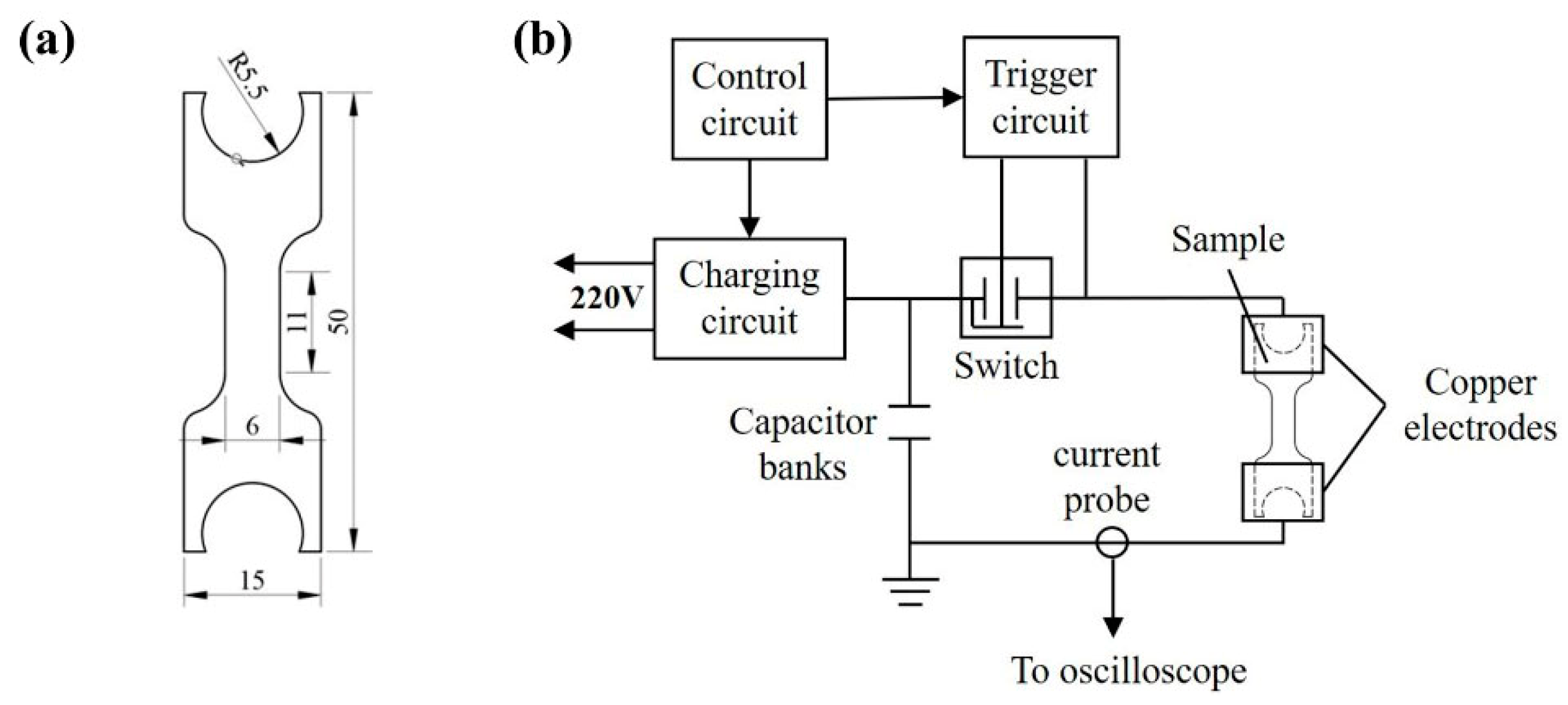

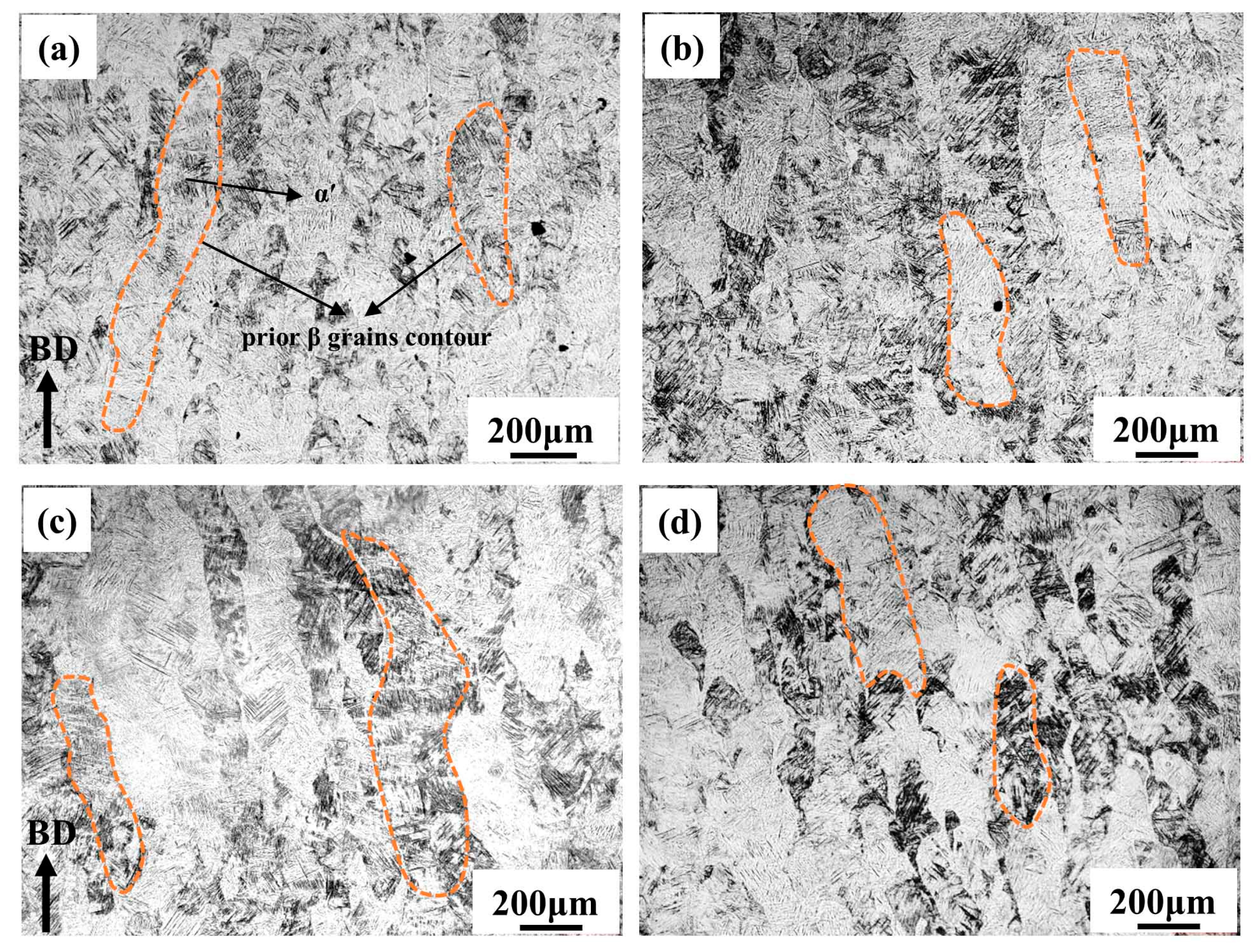
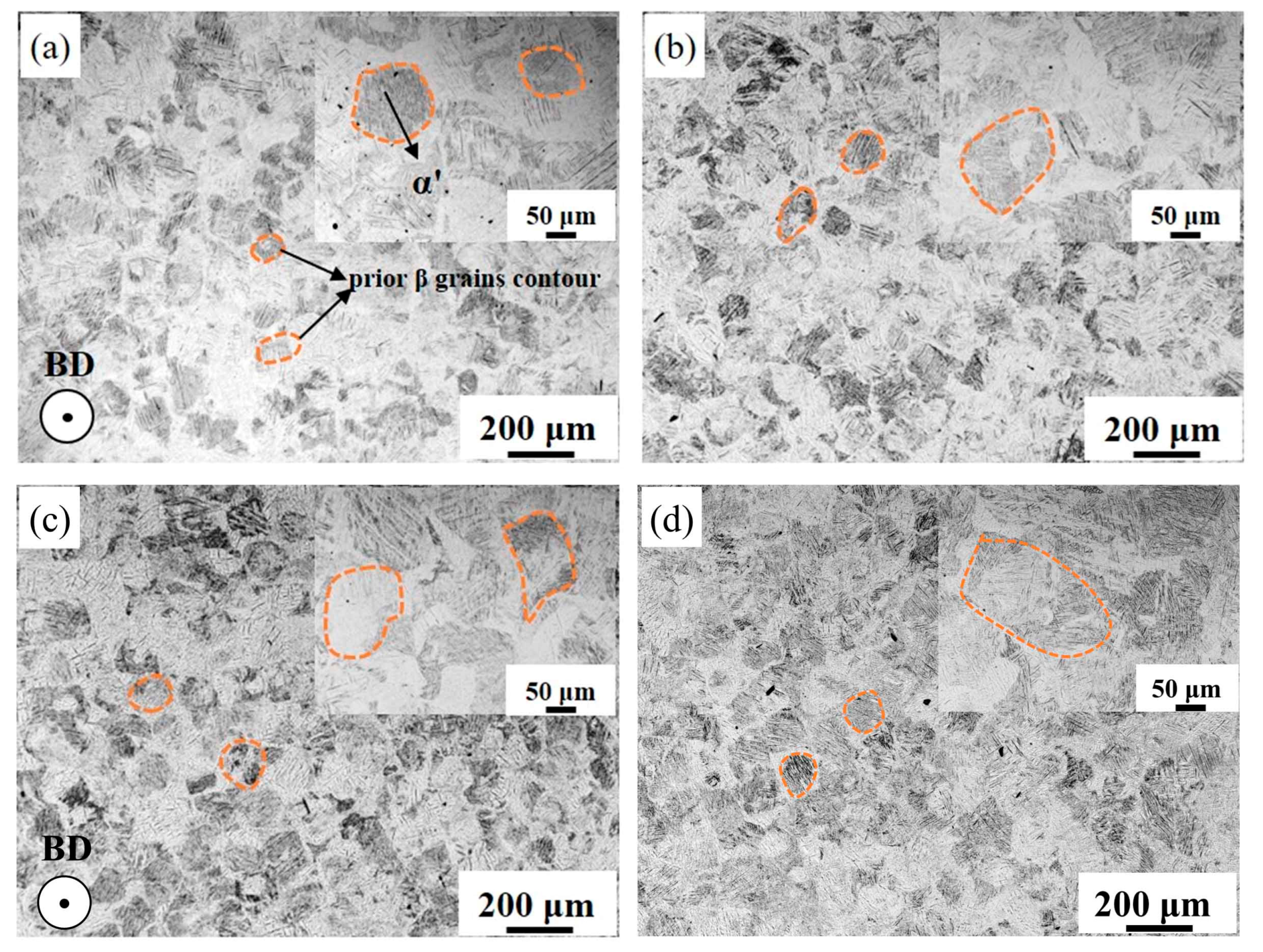
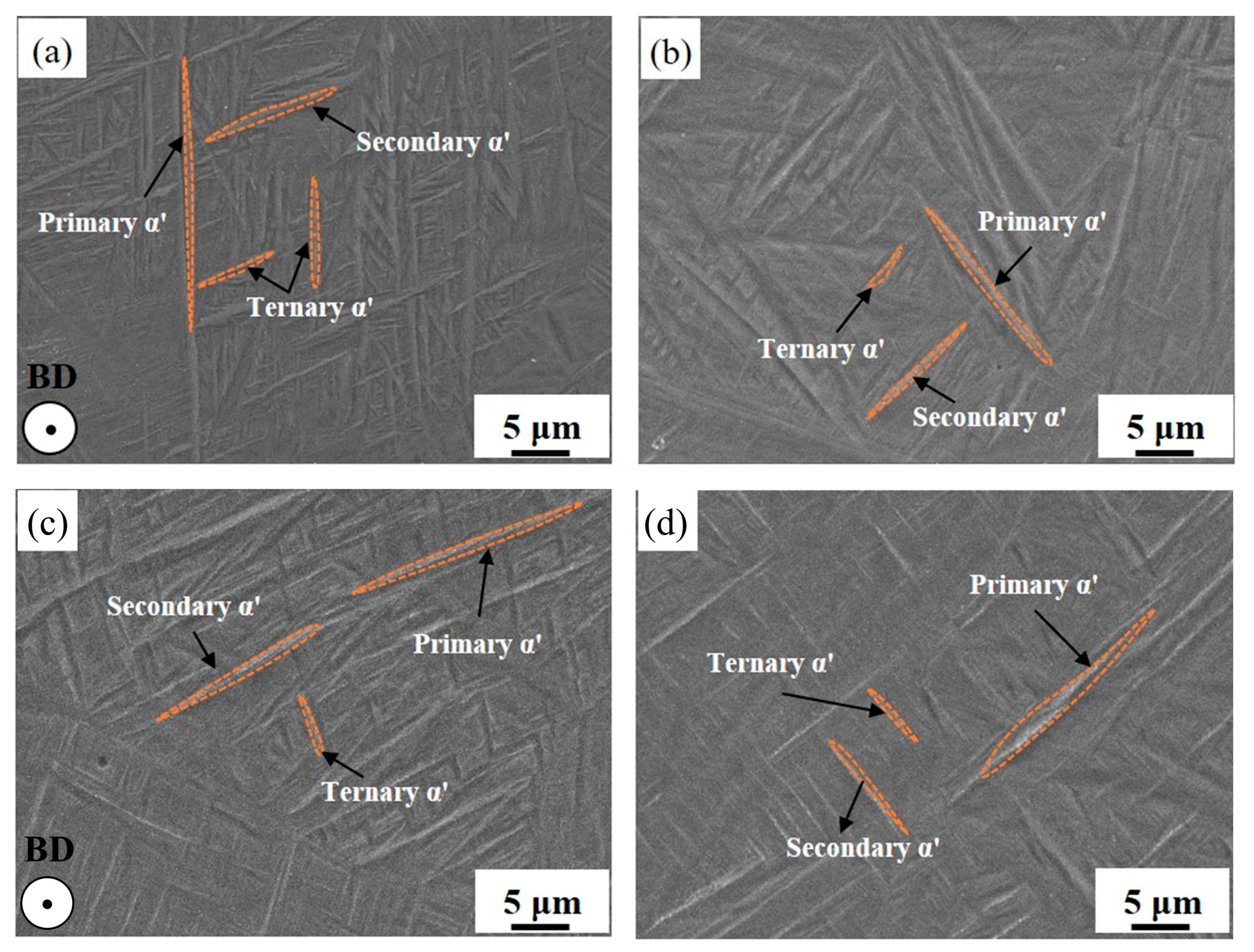


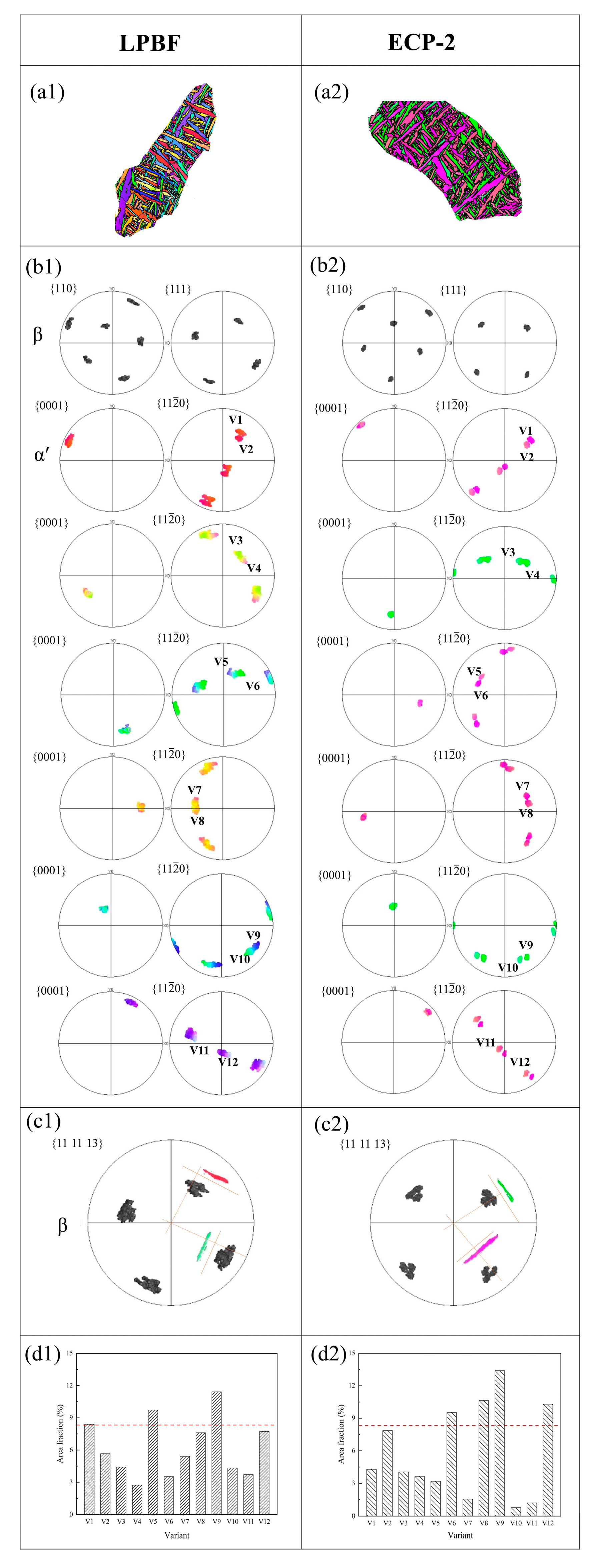
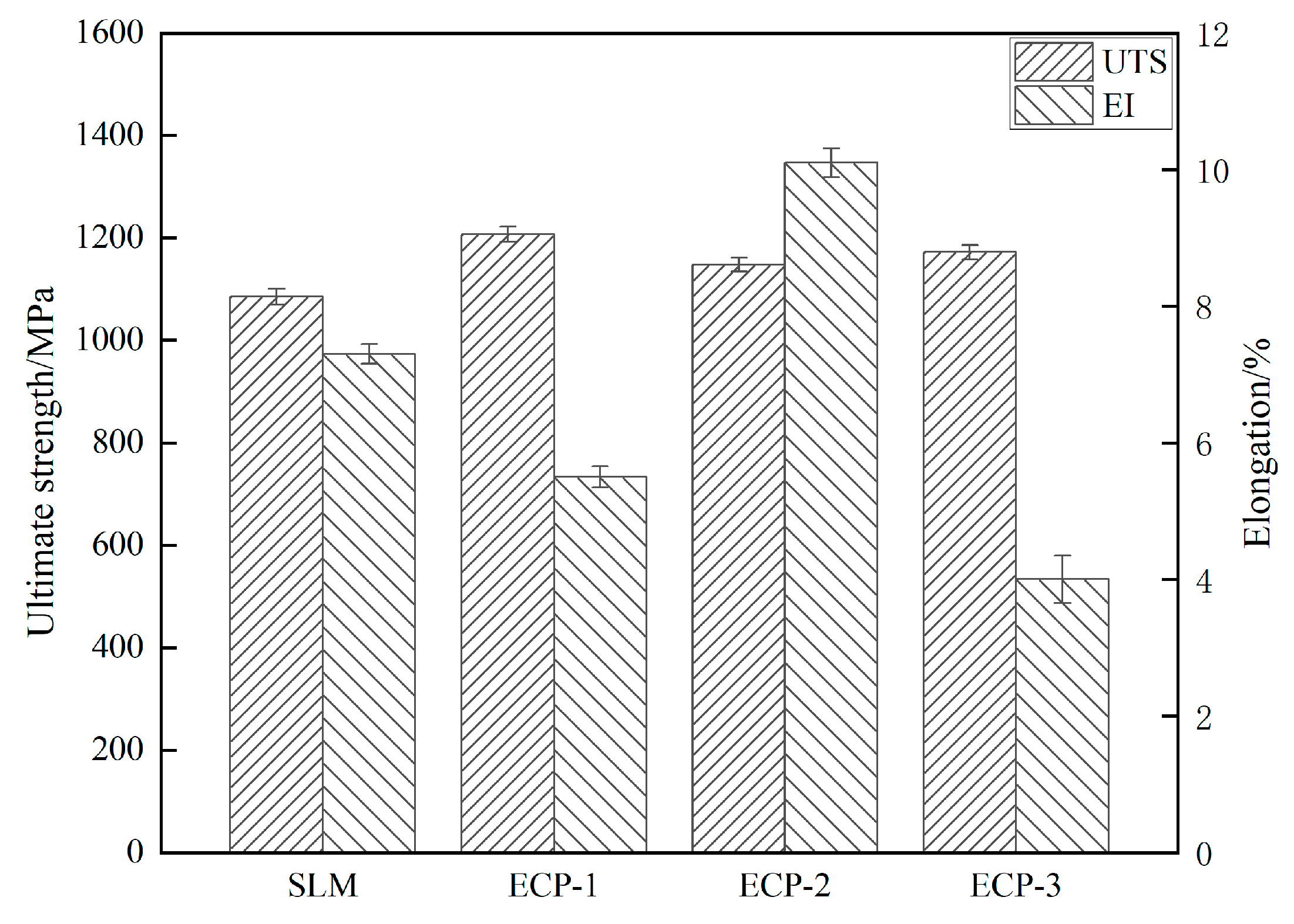
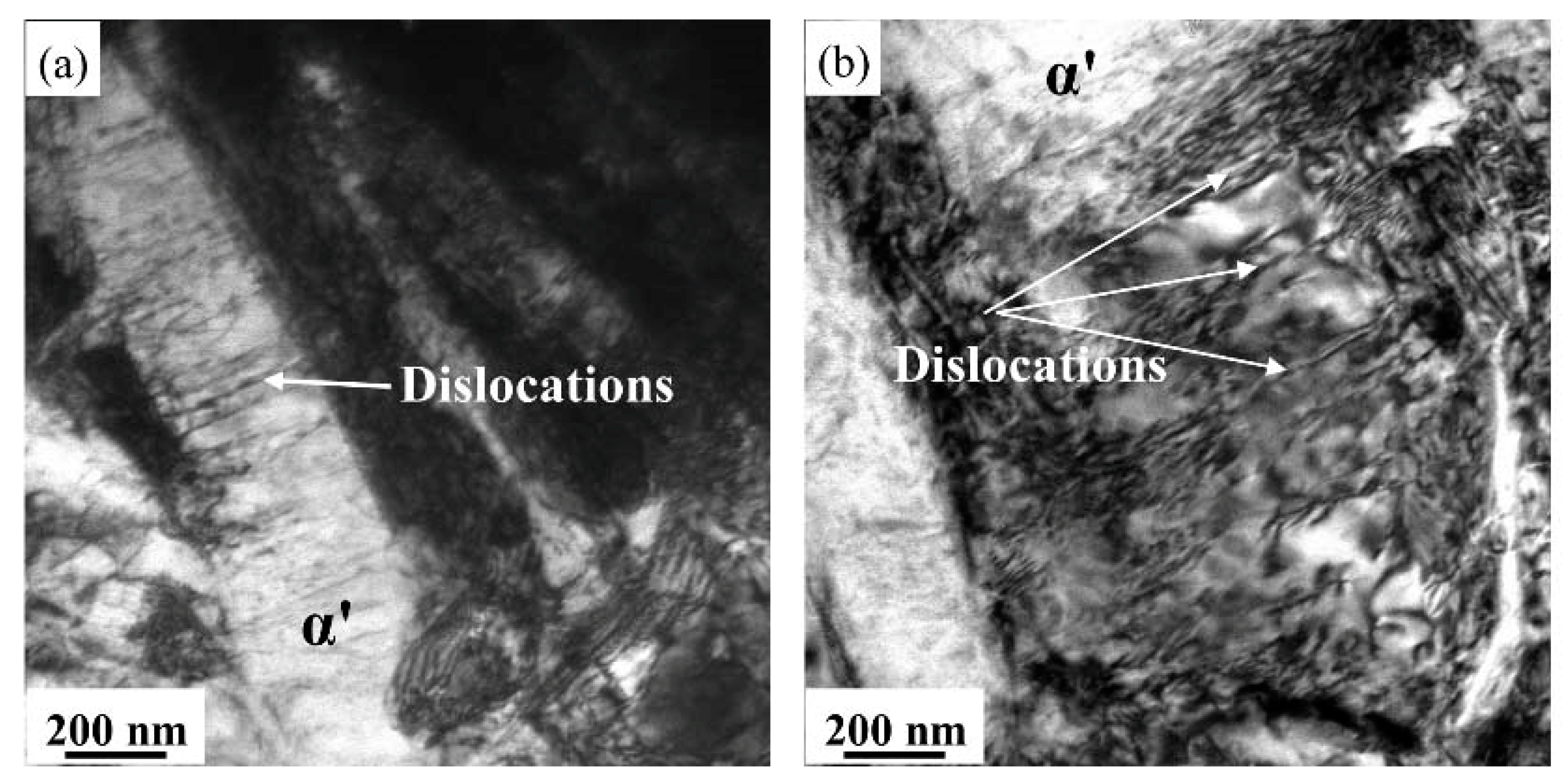
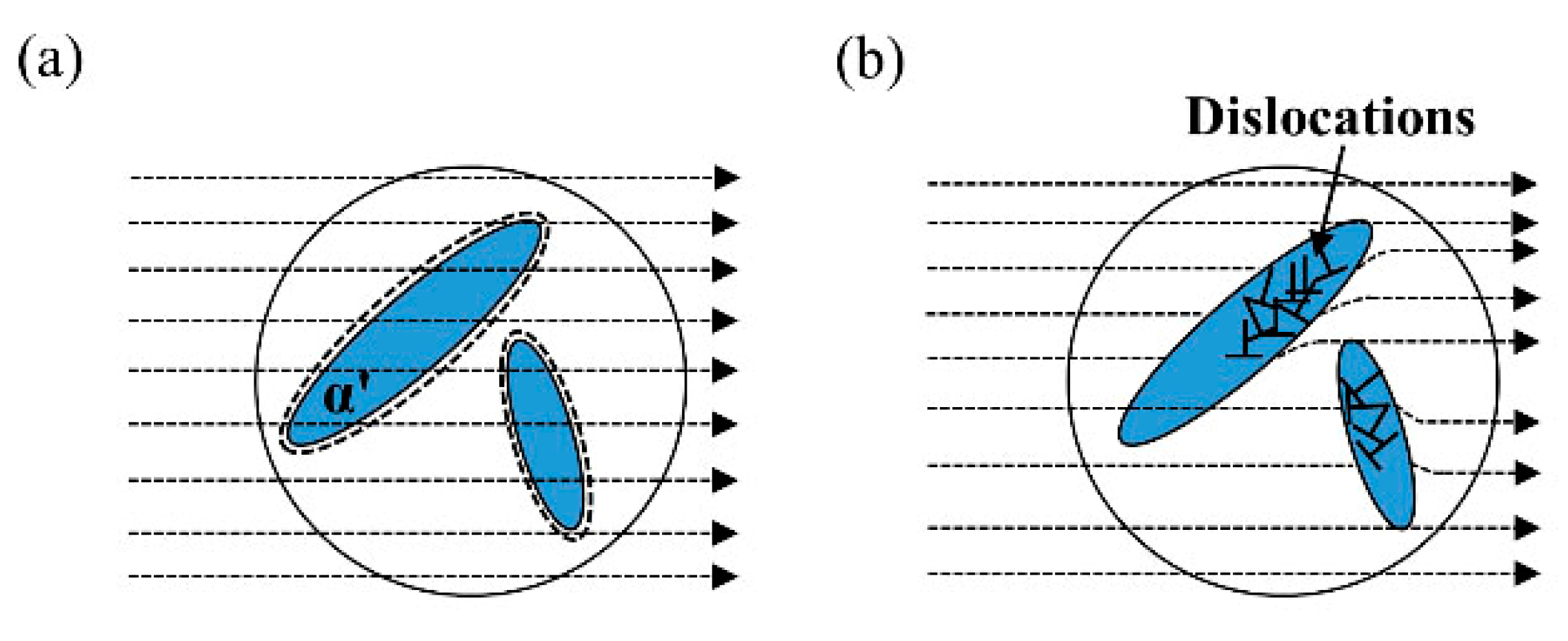
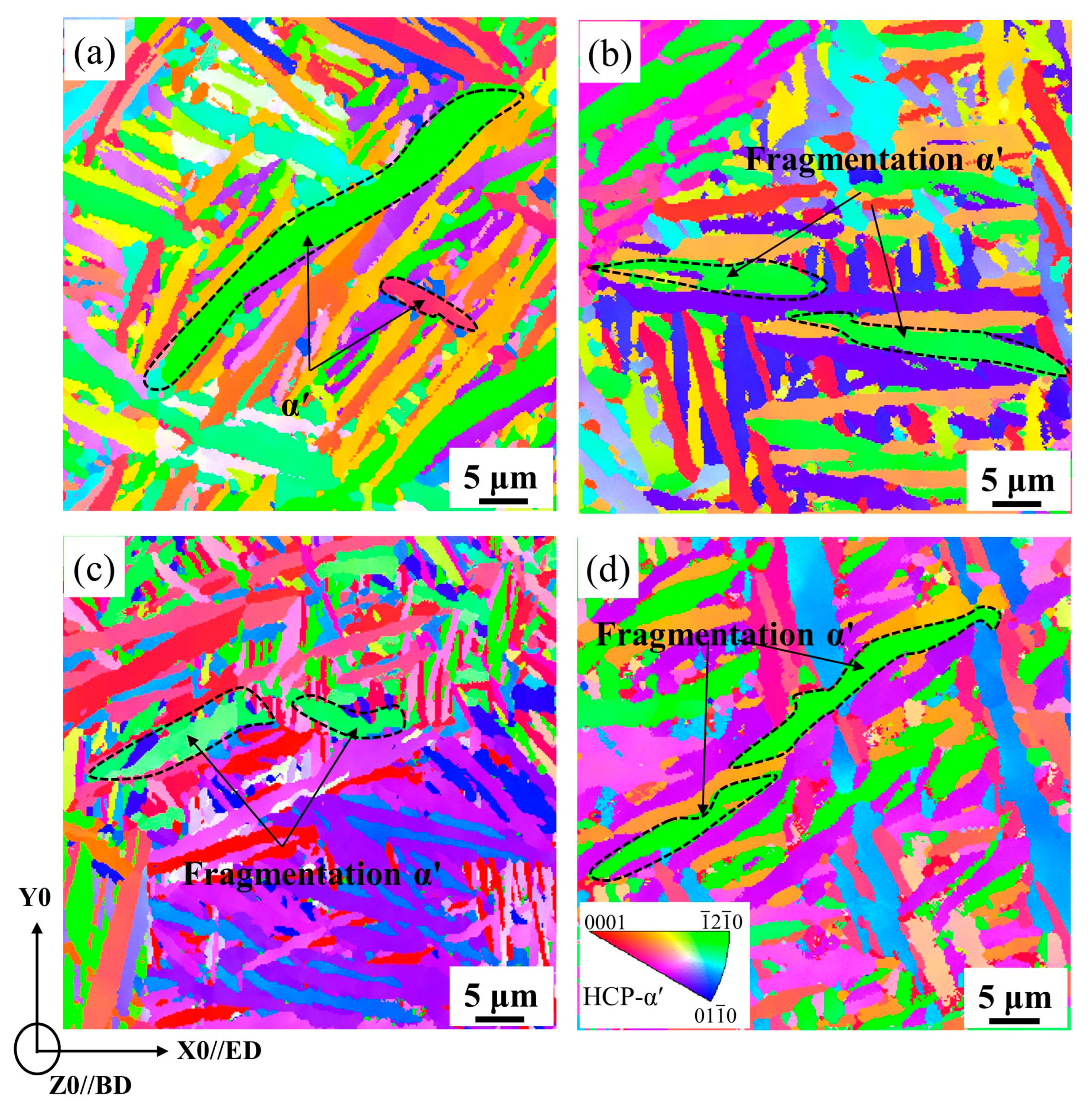

| Ti | Al | V | Fe | Other Elements |
|---|---|---|---|---|
| Bal. | 6.44 | 4.15 | 0.19 | 0.5 |
| Sample | Current Density (A/mm2) | Pulse Duration (s) | Temperature (℃) |
|---|---|---|---|
| LPBF | - | - | - |
| ECP-1 | 42.59 | 15 | 630 |
| ECP-2 | 48.37 | 15 | 700 |
| ECP-3 | 53.15 | 15 | 760 |
| Sample | a | c | c/a |
|---|---|---|---|
| LPBF | 0.292 | 0.467 | 1.599 |
| ECP-1 | 0.291 | 0.466 | 1.601 |
| ECP-2 | 0.291 | 0.466 | 1.601 |
| ECP-3 | 0.292 | 0.467 | 1.599 |
| Samples | Length of Major Axis (μm) | Change Rate | Length of Minor Axis (μm) | Change Rate | Aspect Ratio | Change Rate |
|---|---|---|---|---|---|---|
| LPBF | 376.39 | - | 108.58 | - | 3.47 | - |
| ECP-1 | 340.88 | −9.44% | 127.64 | +17.55% | 2.67 | −23.04% |
| ECP-2 | 349.34 | −7.19% | 130.96 | +20.61% | 2.67 | −23.13% |
| ECP-3 | 238.66 | −36.59% | 132.84 | +22.34% | 1.80 | −48.22% |
| Samples | Length (μm) | Change Rate | Aspect Ratio | Change Rate |
|---|---|---|---|---|
| LPBF | 103.38 | - | 1.26 | - |
| ECP-1 | 120.71 | +16.76% | 1.20 | −4.76% |
| ECP-2 | 126.30 | +22.17% | 1.32 | +4.76% |
| ECP-3 | 128.93 | +24.71% | 1.19 | −5.56% |
| Samples | Length of Major Axis (μm) | Change Rate | Length of Minor Axis (μm) | Change Rate |
|---|---|---|---|---|
| LPBF | 7.31 | - | 1.17 | - |
| ECP-1 | 6.34 | −13.27% | 1.14 | −2.56% |
| ECP-2 | 5.08 | −30.51% | 0.86 | −26.50% |
| ECP-3 | 6.07 | −16.96% | 1.31 | +11.97% |
| Scale | LPBF | ECP−1 | Change Rate | ECP−2 | Change Rate | ECP−3 | Change Rate |
|---|---|---|---|---|---|---|---|
| 0–3 | 12.60 | 25.17 | +99.76% | 31.20 | +147.62% | 24.65 | +95.63% |
| 3–6 | 38.76 | 37.41 | −3.48% | 44.14 | +13.88% | 39.38 | +1.60% |
| 6–10 | 25.97 | 21.72 | −16.37% | 14.92 | −42.55% | 21.24 | −18.21% |
| 10–15 | 14.73 | 10.00 | −32.11% | 6.24 | −57.64% | 10.23 | −30.55% |
| >15 | 7.95 | 5.69 | −28.43% | 3.50 | −55.97% | 4.50 | −43.40% |
| Samples | UTS (MPa) | Δσ | EI (%) | Δδ |
|---|---|---|---|---|
| LPBF | 1062 | - | 7.5 | - |
| ECP-1 | 1207 | +13.65% | 5.5 | −26.67% |
| ECP-2 | 1148 | +8.10% | 10.1 | +34.67% |
| ECP-3 | 1172 | +10.36% | 4 | −46.67% |
Publisher’s Note: MDPI stays neutral with regard to jurisdictional claims in published maps and institutional affiliations. |
© 2022 by the authors. Licensee MDPI, Basel, Switzerland. This article is an open access article distributed under the terms and conditions of the Creative Commons Attribution (CC BY) license (https://creativecommons.org/licenses/by/4.0/).
Share and Cite
Fan, S.; He, B.; Liu, M. Effect of Pulse Current Density on Microstructure of Ti-6Al-4V Alloy by Laser Powder Bed Fusion. Metals 2022, 12, 1327. https://doi.org/10.3390/met12081327
Fan S, He B, Liu M. Effect of Pulse Current Density on Microstructure of Ti-6Al-4V Alloy by Laser Powder Bed Fusion. Metals. 2022; 12(8):1327. https://doi.org/10.3390/met12081327
Chicago/Turabian StyleFan, Shijing, Bo He, and Meishuai Liu. 2022. "Effect of Pulse Current Density on Microstructure of Ti-6Al-4V Alloy by Laser Powder Bed Fusion" Metals 12, no. 8: 1327. https://doi.org/10.3390/met12081327






